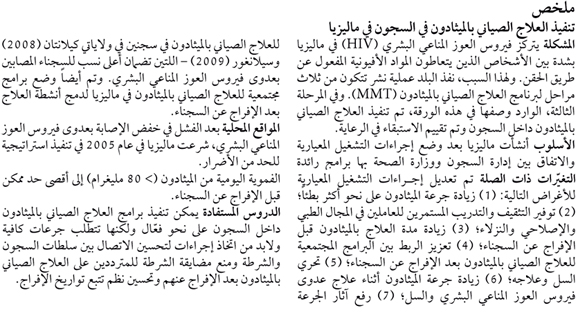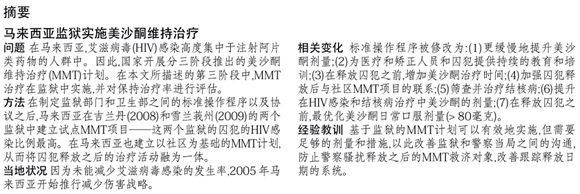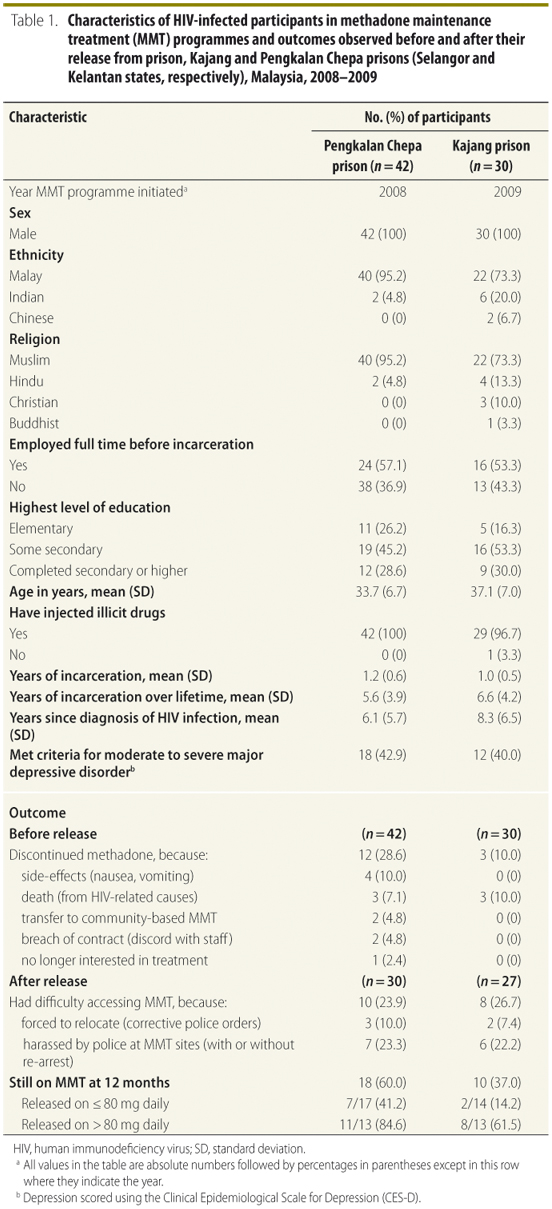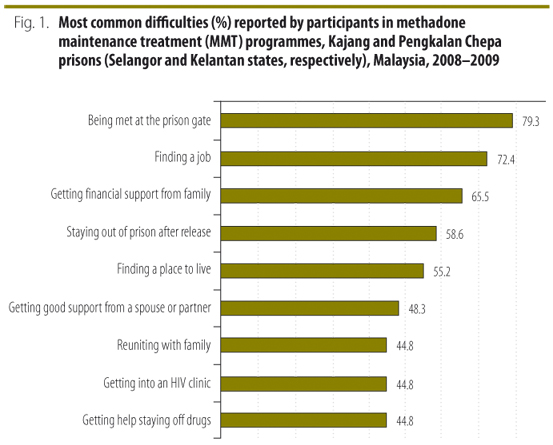LESSONS FROM THE FIELD
Implementing methadone maintenance treatment in prisons in Malaysia
Mise en place du traitement de maintien à la méthadone dans les prisons de Malaisie
La aplicación del tratamiento de mantenimiento con metadona en prisiones de Malasia
Jeffrey A WickershamI; Ruthanne MarcusI; Adeeba KamarulzamanII; Muhammad Muhsin ZahariII; Frederick L AlticeI, II,*
IYale University School of Medicine, Department of Medicine, Infectious Diseases Section, AIDS Program, 135 College Street (Suite 323), New Haven, CT 06510 2283, United States of America (USA)
IIUniversity of Malaya, Centre of Excellence for Research in AIDS, Kuala Lumpur, Malaysia
ABSTRACT
PROBLEM: In Malaysia, human immunodeficiency virus (HIV) infection is highly concentrated among people who inject opioids. For this reason, the country undertook a three-phase roll-out of a methadone maintenance treatment (MMT) programme. In Phase 3, described in this paper, MMT was implemented within prisons and retention in care was assessed.
APPROACH: After developing standard operating procedures and agreement between its Prisons Department and Ministry of Health, Malaysia established pilot MMT programmes in two prisons in the states of Kelantan (2008) and Selangor (2009) those with the highest proportions of HIV-infected prisoners. Community-based MMT programmes were also established in Malaysia to integrate treatment activities after prisoners' release.
LOCAL SETTING: Having failed to reduce the incidence of HIV infection, in 2005 Malaysia embarked on a harm reduction strategy.
RELEVANT CHANGES: Standard operating procedures were modified to: (i) escalate the dose of methadone more slowly; (ii) provide ongoing education and training for medical and correctional staff and inmates; (iii) increase the duration of methadone treatment before releasing prisoners; (iv) reinforce linkages with community MMT programmes after prisoners' release; (v) screen for and treat tuberculosis; (vi) escalate the dose of methadone during treatment for HIV infection and tuberculosis; and (vii) optimize the daily oral dose of methadone (> 80 mg) before releasing prisoners.
LESSONS LEARNT: Prison-based MMT programmes can be effectively implemented but require adequate dosing and measures are needed to improve communication between prison and police authorities, prevent police harassment of MMT clients after their release, and improve systems for tracking release dates.


RÉSUMÉ
PROBLÈME: En Malaisie, l'infection par le virus de l'immunodéficience humaine (VIH) est fortement présente chez les personnes qui s'injectent des opioïdes. Pour cette raison, le pays a entrepris la mise en place en trois phases d'un programme de traitement de maintien à la méthadone (TMM). Dans la phase 3, décrite dans ce document de travail, le TMM a été mis en place au sein des prisons, et on a évalué la rétention dans les soins.
APPROCHE: Après avoir élaboré des modes opératoires normalisés et obtenu un accord entre son administration pénitentiaire et son ministère de la Santé, la Malaisie a mis au point des programmes de TMM pilotes dans deux prisons des États de Kelantan (2008) et de Selangor (2009), là où les proportions de détenus infectés par le VIH sont les plus fortes. Des programmes de TMM communautaires ont également été créés en Malaisie pour intégrer des activités de maintien après la libération de prisonniers.
ENVIRONNEMENT LOCAL: N'ayant pas réussi à réduire l'incidence de l'infection par le VIH, la Malaisie a lancé en 2005 une stratégie de réduction des risques.
CHANGEMENTS PERTINENTS: Les modes opératoires normalisés ont été modifiés pour: (i) augmenter plus lentement la dose de méthadone, (ii) offrir en permanence des informations et une formation au personnel médical et pénitentiaire et aux détenus, (iii) allonger la durée du traitement à la méthadone avant de libérer les prisonniers, (iv) renforcer les liens avec les programmes de TMM communautaires après la libération de prisonniers, (v) dépister et traiter la tuberculose, (vi) augmenter la dose de méthadone pendant le traitement contre l'infection par le VIH et la tuberculose, et (vii) optimiser la dose orale quotidienne de méthadone (> 80 mg) avant de libérer les prisonniers.
LEÇONS TIRÉES: Les programmes de TMM en milieu carcéral peuvent être efficacement mis en uvre, mais ils nécessitent un dosage adéquat et des mesures sont nécessaires pour améliorer la communication entre les autorités pénitentiaires et policières, pour éviter les tracasseries policières des patients suivant un TMM après leur libération et pour optimiser les systèmes de suivi des dates de libération.

RESUMEN
SITUACIÓN: En Malasia, la infección por el virus de la inmunodeficiencia humana (VIH) se concentra principalmente entre las personas que se inyectan opiáceos. Por este motivo, el país ha comenzado a introducir un programa de tres fases para el tratamiento de mantenimiento con metadona (TMM). En la tercera fase, descrita en este artículo, se aplicó el TMM en prisiones y se evaluó la atención ininterrumpida a los pacientes.
ENFOQUE: Tras desarrollar unos procedimientos operativos estándar y un acuerdo con el departamento de prisiones y el Ministerio de sanidad, Malasia estableció programas piloto de TMM en dos prisiones en los estados de Kelantan (2008) y Selangor (2009), en las que se dan las proporciones más altas de presos seropositivos. También se establecieron programas TMM de base comunitaria con objeto de integrar las actividades terapéuticas tras la puesta en libertad de los presos.
MARCO REGIONAL: Tras fracasar el intento de reducir la incidencia de la infección por el VIH, Malasia se embarcó en el año 2005 en una estrategia de reducción de daños.
CAMBIOS IMPORTANTES: Se modificaron los procedimientos operativos estándar para: (i) aumentar la dosis de metadona más lentamente; (ii) proporcionar educación continua y formación para el personal médico y del correccional, así como para los reclusos; (iii) aumentar la duración del tratamiento con metadona antes de la puesta en libertad de los presos; (iv) reforzar los vínculos con los programas TMM de base comunitaria tras la puesta en libertad de los presos; (v) diagnosticar y tratar la tuberculosis; (vi) aumentar la dosis de metadona durante el tratamiento contra la infección por VIH y la tuberculosis; y (vii) optimizar la dosis oral diaria de metadona (> 80 mg) antes de poner en libertad a los presos.
LECCIONES APRENDIDAS: Es posible aplicar programas de TMM con base en las prisiones eficazmente, pero se requiere una dosificación adecuada y la adopción de medidas para mejorar la comunicación entre las autoridades policiales y de prisiones, prevenir el acoso policial a los usuarios de TMM tras su puesta en libertad y mejorar los sistemas de seguimiento de las fechas de liberación.
Introduction
In 2005, Malaysia, a middle-income country, was in the throes of one of south-eastern Asia's most explosive epidemics of human immunodeficiency virus (HIV) infection. The epidemic was largely concentrated among people who inject drugs, especially opioids, who comprised more than 1.3% of the population between the ages of 15 and 64 years. Nearly half of all new HIV infections in Malaysia occur among people who inject opioids. In light of this and of the lack of progress towards achieving the Millennium Development Goal of reducing the rate of HIV infection, Malaysia introduced needle and syringe exchange programmes and methadone maintenance treatment (MMT) programmes in 2005 as part of a harm reduction strategy targeting people who inject opioids.1
MMT, an evidence-based therapy for opioid dependence, has been associated with numerous benefits. In addition to reducing opioid use, it lowers risky practices, HIV transmission and criminal behaviour.2 Within prisons, MMT has been shown to dramatically reduce deaths from drug overdose,3 which is the leading direct cause of death over the two weeks that immediately follow release from prison.4 Despite this evidence of their benefits in the community5,6 and in criminal justice settings,711 MMT programmes have expanded very slowly and continue to have low coverage. In this report we describe how Malaysia initiated MMT within two prisons and examine the obstacles that hampered implementation and retention in care after prisoners' release. Such lessons may be useful in other settings where plans to establish harm reduction programmes for HIV-infected individuals who inject opioids are under way.
Setting and approach
In Malaysia, which has a population of 28.3 million, an estimated 205 000 people inject illicit drugs and 78 419 people have HIV infection. The country has approximately 43 000 prisoners and an incarceration rate of 174 per 100 000. Testing of prisoners for HIV is mandatory; about 6% of them test positive.12
Malaysia's initial experience with the implementation of needle and syringe exchange programmes and MMT programmes has been described elsewhere.13,14 The MMT programme was rolled out in three phases. In Phase I, MMT was introduced in specialty clinics for people with drug dependence, and in Phase II it was expanded to primary care settings. In 2006 prison officials including the Director-General of the Malaysian Prisons Department, made a site visit to Iranian prisons to learn more about the use of MMT in an Islamic context. By 2007, Malaysia's Prisons Department had decided to pilot an MMT programme in an attempt to reduce HIV infection and reincarceration rates. In partnership with the Ministry of Health and leading national and international experts, the department developed standard operating procedures for deployment of MMT in prisons by adapting the operating procedures in place for community-based MMT. The standard operating procedures for prisons called for initiation of MMT from 3 to 6 months before a prisoner's release, slow escalation of the methadone dose because of the danger of intolerance to opioids, and the establishment of mechanisms for referring patients to community-based MMT after their release from prison. In this paper we present the data from Phase III, which consisted of the rollout of methadone in the two prisons in Malaysia with the highest prevalence of HIV infection among their inmates.
The first pilot MMT study began in Pengkalan Chepa prison, in the state of Kelantan, in 2008. Later the same year the programme was expanded to Kajang prison, in the state of Selangor. Participants in both pilot programmes were observed for 12 months. We first used MMT in prisoners who were HIV-infected to facilitate their medical care after their release. Because prison health programmes in Malaysia were at an early stage of development, the United Nations Office on Drugs and Crime funded intensive training for prison clinicians and correctional staff, as well as for community-based MMT programme providers. Officials from the Prisons Department and physicians prescribing methadone in the prison and community were selected for this training.
For the analysis we divided the factors that stood as deterrents and facilitators to the implementation of these prison-based MMT programmes into three categories: patient-, staff- and institution-level factors. We conducted one-on-one interviews with clients, both in the prison before their release and regularly after their release, to assess their experiences with the programme. Focus groups of 8 prisoners released from Pengkalan Chepa and 11 released from Kajang prison who had remained on MMT were conducted to gather more detailed information about their experiences with methadone treatment. We also spoke with prison physicians prescribing methadone about their experiences throughout the course of the pilot programme.
Patient-level factors
Under the former standard operating procedures, the daily starting dose of 5 mg of methadone was escalated by 5 mg every 3 to 4 days. In Pengkalan Chepa we found that this escalation rate was too rapid; many patients experienced severe nausea, vomiting and somnolence. For this reason, in Kajang we escalated the dose by 5 mg every 7 days rather than every 5, and no patients experienced these symptoms. We had to extend treatment duration to more than 3 months to allow sufficient time to escalate the daily dose of methadone to more than 80 mg before a prisoner's release. Ongoing training of physicians and patients was required to ensure that escalation of the dose of methadone was individualized in accordance with each patient's symptoms. We also observed high rates of abstinence syndrome and in several cases had to increase the dose of methadone. This occurred most often in patients who were receiving anti-tuberculosis agents or antiretroviral therapy (ART), both of which can markedly reduce methadone levels.2 About one fourth of the MMT programme participants in both prisons had to be treated for tuberculosis. This was a surprisingly high percentage, although the incidence of tuberculosis is known to be high among HIV-infected prisoners. Patients who were released from prison on a daily methadone dose of more than 80 mg had better treatment retention rates 12 months after release than those who were released on a lower dose (Table 1).15 This finding has also been observed in community-based MMT programmes.16

Most prisoners were unwilling to have their HIV status disclosed to their families but requested that their families be educated about the benefits of MMT. Many prisoners were poorly connected with their families because of their opioid dependence and believed that being "treated" would help them to restore their broken family ties. Prisoners' relatives seemed to appreciate being taught about MMT, yet some of them quarantined former prisoners within the household and treated them with distrust. Finally, despite knowing that MMT has long-term benefits, many patients expected to have all opioids eventually discontinued.
Staff-level factors
At first the primary care physicians in the prison were reluctant to initiate MMT because they felt uncomfortable treating opioid dependence. This was resolved through one-on-one supervision and training, which covered the rationale behind MMT, appropriate dosing of the drug, its adverse side-effects, its pharmacokinetic interactions, and the logistical issues involved in providing for patients' transitional care. Physicians and patients both wanted to keep doses "low" because they feared the "addictive" effects of MMT. A daily dose of more than 80 mg was established to reduce under-prescribing. In the planning stage there were concerns about possible diversion and overdose; these concerns did not materialize after the standard operating procedures pertaining to clinical care were developed. In Pengkalan Chepa, patients on MMT were initially quarantined while their methadone dose was escalated, but since no adverse effects were observed, this practice was later discontinued. Occasionally, inmates and prison staff engaged in anti-methadone rhetoric that discouraged patients on MMT from continuing their therapy. To overcome this problem and reinforce treatment goals, separate educational sessions for inmates and staff were conducted periodically, generally 3 to 6 months after initiation of the pilot programme.
Educational sessions on the benefits of MMT had to be held repeatedly because of the turnover in prison staff. The highest-ranking prison officials supported the MMT programme, but the high turnover in lower-ranking staff threatened to undermine it. To allay their doubts and address their concerns, we reassured officials that the pilot studies were being monitored and provided programmatic feedback and interactive discussions quarterly. Although all prison officials should receive standardized training, continuing training and monitoring were instructive and helpful in avoiding disruption of the MMT programme as a result of frequent changes in staff.
Institutional-level factors
One critical facilitator and four institutional deterrents were observed during the implementation of MMT programmes. Central to success was the support of the Director-General of the Prisons Department, who was involved from the inception of the programme. Four institutional deterrents, however, also acted as hindrances. First, local police could impose corrective measures without notifying the Prisons Department. For example, they could order prisoners to be relocated to a remote area after their release. Last minute coordination was required to ensure that community-based prisoners had access to a site offering MMT. As a result, relocated patients were less likely to be retained in treatment. Second, the exact date of a prisoner's release was not always known in advance. All patients on MMT were therefore instructed to inform prison staff of their treatment so that their release from prison could be delayed until after their next dose of MMT and the prison physician had had a chance to have their MMT records transferred to a community MMT site. Third, "lock-downs" periods when staff put a stop to all movement within the prison for security reasons threatened to impede prisoners' access to MMT, and physicians responded in anticipation of such events by distributing methadone directly to their cells. Finally, some community-based MMT programmes reduced patients' methadone dose after release from prison because they mistakenly considered it too high. Hence, the staff of community-based MMT sites must be made aware of the importance of a high enough maintenance dose of methadone and of the need to escalate the dose in patients released from prison receiving 80 mg or less a day.
Post-release continuity of care
Ensuring continuity of care after release from prison remains difficult because patient supervision lies outside the prison system. Since most MMT programmes are located in urban settings, individuals returning to rural settings had to either forfeit MMT or agree to travel to a community MMT site. A travel distance of more than 25 km was associated with lower retention in treatment. As community-based MMT programmes expand to rural areas, so too can prison-based MMT programmes. Linking patients to MMT upon release was not difficult when the pre-release paperwork was completed in advance and properly transmitted to the community MMT site, especially when accompanied by a phone call to ensure receipt.
Despite education of family members about MMT, reuniting patients with their families often proved problematic; many patients were met with hostility by their relatives. Innovative, culturally-specific educational sessions should be provided before and after release to reduce family conflict around MMT. Re-integration with the family is the most critical aspect of re-entry into society. For patients lacking family support, however, transitional services that provided assistance with reintegration into society (e.g. employment, housing, care for HIV infection, etc.) were just as important in ensuring their retention in MMT.
Finally, retention in care was hindered by arrest and harassment of MMT clients by police near MMT sites. Some patients reported they avoided coming to receive their methadone on days when police were waiting outside the programme, or, in some cases, that they discontinued it completely to avoid being detained or bribed. As a result, police were subsequently educated about the benefits of MMT. On the whole, however, prisoners did not report lack of continuity of MMT as their main problem upon re-entering society. Fig. 1 provides a list of the problems they considered most important. Staying off illicit drugs was not highest among them.12

Conclusion
Prison-based MMT holds considerable promise for reducing HIV infection rates among prison inmates and the general population (Box 1). Implementing MMT in prisons is not easy, although the difficulties are not insurmountable. Other evidence-based opioid agonists, such as buprenorphine or extended-release naltrexone, are used to treat opioid dependence, although transitioning to a community programme may be more difficult with naltrexone, which is administered only once a month.17 Experiences in Malaysia could prove useful in other countries with high rates of opioid dependence and HIV infection among prison inmates. Future interventions should not, however, focus on MMT as an intervention for exclusive use immediately before a prisoner's release from prison. Instead, MMT should be leveraged throughout the period of incarceration not only to ensure continuity of care for MMT programme participants, but also to ensure adequate MMT dosing before release from prison and avoid the risky injection of opioids within prisons. 

Funding: This research was supported by research grants from the National Institute on Drug Abuse for research (R01 DA025943, Altice, PI) and a grant from the University of Malaya (HIRGA E000001-20001, Kamarulzaman), as well as a National Institute on Drug Abuse career development award (K24 DA017072, Altice).
Competing interests: None declared.
References
1. Malaysia country advocacy brief: injecting drug use and HIV. Geneva: Joint United Nations Programme on HIV/AIDS; 2009.
2. Altice FL, Kamarulzaman A, Soriano VV, Schechter M, Friedland GH. Treatment of medical, psychiatric, and substance-use comorbidities in people infected with HIV who use drugs. Lancet 2010;376:36787. doi:10.1016/S0140-6736(10)60829-X PMID:20650518
3. Hedrich D, Alves P, Farrell M, Stöver H, Møller L, Mayet S. The effectiveness of opioid maintenance treatment in prison settings: a systematic review. Addiction 2012;107:50117. doi:10.1111/j.1360-0443.2011.03676.x PMID:21955033
4. Merrall EL, Kariminia A, Binswanger IA, Hobbs MS, Farrell M, Marsden J et al. Meta-analysis of drug-related deaths soon after release from prison. Addiction 2010;105:154554. doi:10.1111/j.1360-0443.2010.02990.x PMID:20579009
5. Schwartz RP, Highfield DA, Jaffe JH, Brady JV, Butler CB, Rouse CO et al. A randomized controlled trial of interim methadone maintenance. Arch Gen Psychiatry 2006;63:1029. doi:10.1001/archpsyc.63.1.102 PMID:16389204
6. Schwartz RP, Kelly SM, O'Grady KE, Mitchell SG, Peterson JA, Reisinger HS et al. Attitudes toward buprenorphine and methadone among opioid-dependent individuals. Am J Addict 2008;17:396401. doi:10.1080/10550490802268835 PMID:18770082
7. Dolan KA, Wodak AD, Hall WD. Methadone maintenance treatment reduces heroin injection in New South Wales prisons. Drug Alcohol Rev 1998;17:1538. doi:10.1080/09595239800186951 PMID:16203480
8. Howells C, Allen S, Gupta J, Stillwell G, Marsden J, Farrell M. Prison based detoxification for opioid dependence: a randomised double blind controlled trial of lofexidine and methadone. Drug Alcohol Depend 2002;67:16976. doi:10.1016/S0376-8716(02)00024-8 PMID:12095666
9. Kerr T, Jurgens R. Methadone maintenance therapy in prisons: reviewing the evidence. Montreal: Canadian HIV/AIDS Legal Network; 2004.
10. Kinlock TW, Gordon MS, Schwartz RP, Fitzgerald TT, O'Grady KE. A randomized clinical trial of methadone maintenance for prisoners: results at 12 months postrelease. J Subst Abuse Treat 2009;37:27785. doi:10.1016/j.jsat.2009.03.002 PMID:19339140
11. Gorta A. Monitoring the New South Wales methadone program: 19861991. New South Wales: Department of Corrective Services; 1992.
12. Choi P, Kavasery R, Desai MM, Govindasamy S, Kamarulzaman A, Altice FL. Prevalence and correlates of community re-entry challenges faced by HIV-infected male prisoners in Malaysia. Int J STD AIDS 2010;21:41623. doi:10.1258/ijsa.2009.009180 PMID:20606222
13. Reid G, Kamarulzaman A, Sran SK. Malaysia and harm reduction: the challenges and responses. Int J Drug Policy 2007;18:13640. doi:10.1016/j.drugpo.2006.12.015 PMID:17689356
14. Noordin NM, Merican MI, Rahman HA, Lee SS, Ramly R. Substitution treatment in Malaysia. Lancet 2008;372:114950. doi:10.1016/S0140-6736(08)61479-8 PMID:18926274
15. Wickersham JA, Zahari MM, Azar MM, Kamarulzaman A, Altice FL. Methadone dose at the time of release from prison significantly influences retention in treatment: implications from a pilot study of HIV-infected prisoners transitioning to the community in Malaysia. Drug Alcohol Depend 2013. In press.
16. Mohamad N, Bakar NH, Musa N, Talib N, Ismail R. Better retention of Malaysian opiate dependents treated with high dose methadone in methadone maintenance therapy. Harm Reduct J 2010;7:30. doi:10.1186/1477-7517-7-30 PMID:21167035
17. Springer SA, Azar MM, Altice FL. HIV, alcohol dependence, and the criminal justice system: a review and call for evidence-based treatment for released prisoners. Am J Drug Alcohol Abuse 2011;37:1221. doi:10.3109/00952990.2010.540280 PMID:21171933
(Submitted: 20 June 2012 Revised version received: 15 October 2012 Accepted: 13 November 2012)
* Correspondence to Frederick L Altice (e-mail: frederick.altice@yale.edu).
